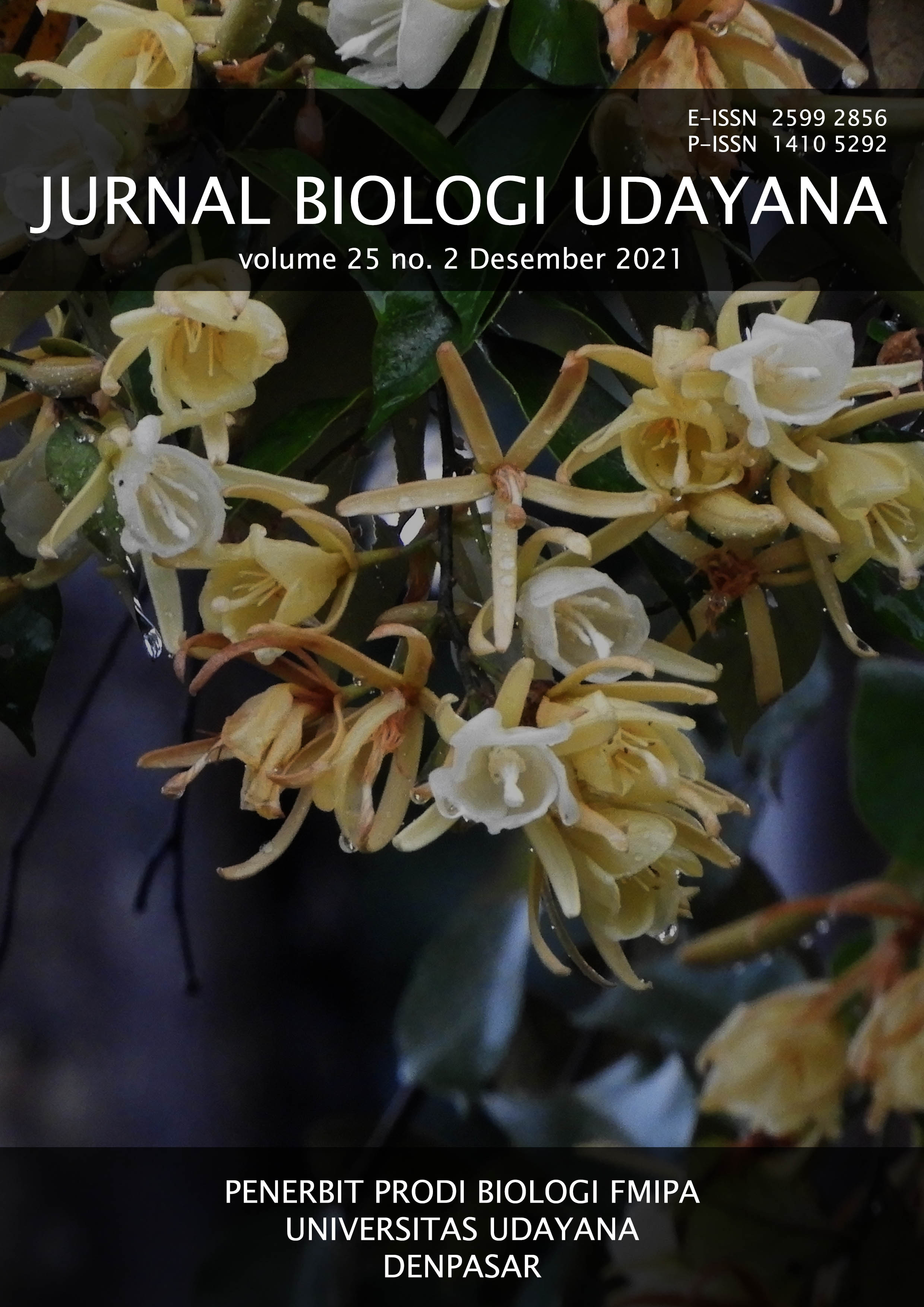Susceptibility of Aedes aegypti larvae in East Java towards commercial Temephos at different doses
Abstract
Control of Ae. Aegypti population is performed as an effort to suppress the transmission of dengue virus, one of the methods is sprinkling of temephos larvicide. Operational dose of temephos used in Indonesia (1 mg/L) is higher from recommended dose of WHO (0.012 mg/L). In East Java, commercial temephos are found to have different application doses of 8 g/L (8G) and 10 g/L (10 G). This study was designed to know the susceptibility of Ae. aegypti population from Jember (JEM), Surabaya (SBY), and Entomology Laboratory of Universitas Airlangga collection (LAB) towards temephos 8G and 10G starting at high (1 mg/L) to low concentrations(0.015625 mg/L). Larvae mortality test was performed based on WHO standard method with 4 times replication. Data was analyzed statistically. Results showed that the three groups of Ae. aegypti larvae had mortality level at >90% in the lowest concentration applied (0.015625 mg/L) at time threshold of 240 minutes, for both temephos8 G and 10 G. Significant difference of larvae mortality towards highest (1 mg/L) and lowest dose (0.015625 mg/L) was found in JEM, at both 8 G and 10 G doses, and LAB at 8 G dose. JEM and SBY groups were found to have resistance ratio 95 (RR95) to temephosat low category (<5) compared to LAB. All groupstill retained susceptibility towards commercial temephos larvicide at low dose (0.015625 mg/L). Based on results, we recommendedlowering the operational dose of larvicide temephos used for population control of Ae. aegypti vector population in East Java.
Downloads
References
Ding F, Fu J, Jiang D, Hao M, Lin G. 2018. Mapping the spatial distribution of Aedes aegypti and Aedes albopictus. Acta Tropica 178(1): 155–162. DOI: 10.1016/j.actatropica.2017.11.020
Haryanto B. 2018. Indonesia Dengue Fever: Status, Vulnerability, and Challenges. Current Topics in Tropical Emerging Diseases and Travel Medicine. IntechOpen, 12. DOI: 10.5772/intechopen.82290
Hasmiwati, Rusjdi SR, Nofita E. 2018. Detection of ace-1 gene with insecticides resistance in aedes aegypti populations from DHF-endemic areas in Padang, Indonesia. Biodiversitas19(1): 31–36. DOI: 10.13057/biodiv/d190105
Ikawati B, Sunaryo, Wahyudi BF. 2017. Aedes aegypti resistance to temephos in Central Java, Indonesia. Advanced Science Letters 23(4): 3544–3546. DOI: 10.1166/asl.2017.9163
Kemenkes RI. 2019. Profil Kesehatan Indonesia 2018 [Indonesia Health Profile 2018].
Kraemer MUG, Sinka ME, Duda KA, Mylne AQN, Shearer FM, Barker CM, Moore CG, Carvalho RG, Coelho GE, Van Bortel W, Hendrickx G, Schaffner F, Elyazar IR, Teng HJ, Brady OJ, Messina JP, Pigott DM, Scott TW, Smith DL, William Wint GR, Golding N, Hay SI. 2015. The global distribution of the arbovirus vectors Aedes aegypti and Ae. Albopictus. eLife 4: e08347. DOI: 10.7554/eLife.08347
Kresnadi I, Amin BF, Ariq H, Akbar VA, Winita R, Ridhawati S, Lisawati S, Firmansyah NE, Wibowo H. 2021. The Susceptibility of Aedes aegypti in Dengue Endemic Areas, Tegal, Central Java Indonesia. Balaba: Jurnal Litbang Pengendalian Penyakit Bersumber Binatang Banjarnegara 17(1): 11–18
Mazzarri MB, Georghiou GP. 1995. Characterization of resistance to organophosphate, carbamate, and pyrethroid insecticides in field populations of Aedes aegypti from Venezuela. Journal of the American Mosquito Control Association 11(3): 315–322
Melo-Santos MAV, Varjal-Melo JJM, Araújo AP, Gomes TCS, Paiva MHS, Regis LN, Furtado AF, Magalhaes T, Macoris MLG, Andrighetti MTM, Ayres CFJ. 2010. Resistance to the organophosphate temephos: Mechanisms, evolution and reversion in an Aedes aegypti laboratory strain from Brazil. Acta Tropica 113(2): 180–189. DOI: 10.1016/j.actatropica.2009.10.015
Mulyaningsih B, Umniyati SR, Satoto TBT, Diptyanusa A, Nugrahaningsih DAA, Selian Y. 2018. Insecticide resistance and mechanisms of Aedes aegypti (Diptera: Culicidae) in Yogyakarta. Journal of thee Medical Sciences (Berkala Ilmu Kedokteran)50(01): 24–32. DOI: 10.19106/jmedsci005001201803
Mulyatno KC, Yamanaka A, Ngadino, Konishi E. 2012. Resistance of Aedes aegypti (L.) larvae to temephos in Surabaya, Indonesia. Southeast Asian Journal of Tropical Medicine and Public Health 43(1): 29–33
Paeporn P, Komalamisra N, Deesin V, Rongsriyam Y, Eshita Y, Thongrungkiat S. 2003. Temephos resistance in two forms of Aedes aegypti and its significance for the resistance mechanism. Southeast Asian Journal of Tropical Medicine and Public Health 34(4): 786–792
Tang SCN, Rusli M, Lestari P. 2020. Climate Variability and Dengue Hemorrhagic Fever in Surabaya, East Java, Indonesia. Indian Journal of Public Health Research & Development11(2): 131. DOI: 10.37506/v11/i2/2020/ijphrd/194770
USA - EPA. 2000. Temephos: Revised HED Chapter for the Registration Eligibility Decision (RED) Document.
World Health Organization (WHO). 2016. Monitoring and Managing Insecticide Resistance in Aedes mosquito Populations.





